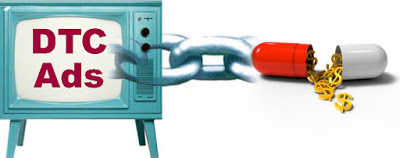TV and, to a lesser extent, print direct-to-consumer (DTC) drug ads have often been blamed for the high price of drugs. For example:
- Physician and pharmacist organizations say DTC ads are a waste of resources, which could be better used to lower drug prices or be plowed back into research (read, for example, “Pharmacists Say DTC Advertising Must Go: It’s ‘Not Working’ & Wastes Resources“).
- Some lawmakers claim that advertising inflates health care costs because consumers are prompted to seek newer, higher-priced medicines (read, for example, “DTC Advertising Moratorium Idea Resurrected in Congress“).
- Others claim that pharma charges higher prices for drugs to cover the cost of advertising (read, for example, “DTC Ad Links to Higher Prices and Less Competition – Plausible or Dubious?“).
Pharma marketers are no doubt concerned that the current political atmosphere, in which both Republicans and Democrats are calling for lower drug prices, is having a negative effect on the effectiveness of their ads as consumers tune out the message (read, for example, “Pharma is Spending More on DTC Advertising But Its Effectiveness is Decreasing, Says New Survey”).
Bob Ehrlich, Chairman of DTC Perspectives, in a recent email titled “Times of Turmoil Ahead” expressed concern that DTC marketers may not adequately understand consumer sentiment viz-a-viz high drug prices:
“Most of us practicing the art and science of DTC have no control over political decisions on drug pricing and drug approval. That being said, it is imperative DTC marketers understand the popular sentiment consumers are exhibiting towards drug companies.”
How does high drug prices affect the work product of DTC marketers and what does Ehrlich propose that DTC marketers do to address consumer concern regarding high drug prices?
Ehrlich advocates “that every brand team must understand consumer reaction to drug prices and anticipate how their DTC affects the perception of price/value. What we can do is study the impact of price on consumers and try to study their attitudes in the context of proposed DTC ads. Does our ad get differing reactions based on the price pre and post consumers being told the price? Would their reactions change our creative approach?”
This is a new – to me – kind of DTC ad focus group study, which I’d like to see. But is it possible for any pharma marketer to do such a study with the blessing of his/her corporate overlords (i.e., upper management who set the prices)? Not likely.
Perhaps the FDA can do such a study? Again, not likely. The FDA does not seem very interested in the prices of drugs it approves and sometimes approves high priced drugs that have limited efficacy (read, for example, “Poll: #FDA Just Blundered Badly re Approval of Duchenne Treatment“); although the agency is known to care about money when it comes to pharma company stock prices (read “Sarepta Complained of “Dire Financial” Ramifications, FDA Caved In on Approval of Duchenne Drug“).
Ehrlich stops short of recommending that marketers address drug prices in DTC ads. That should be addressed “somewhere [else] in the consumer campaign.” Ehrlich does not suggest where.
One thing pharma marketers have tried is to include information about their Patient Assistance Programs (PAPs) in their ads. Astrazeneca has been doing this for years and even hosted a Twitter chat about the program and how to improve it (read, for example, “AstraZeneca to Host First-Ever Pharma-Sponsored Twitter Chat!“). Unfortunately, not many other pharma companies have followed AZ’s lead.
Another tactic is to promote coupons. STATnews reported (here) that “Over the past several years, drug makers have used these to entice consumers to fill their prescriptions, since coupons defray or eliminate copay costs. In 2009, coupons were available for fewer than 100 prescription medicines, but the number exceeded 700 by last year, according to the analysis released on Tuesday by the Tufts Center for the Study of Drug Development. The study was funded by Pfizer.” But, after the coupons expire, consumers end up paying more say some experts (read “Rx Drug Coupons: Lower Costs at First, But You Pay More Later”).
“One thing is certain,” said Ehrlich in closing. “Trumpcare will not forget about lowering drug prices. That is a new reality drug makers will have to adapt to, and DTC programs will need to address it as well.”









![6 Digital Tools at the Center of Healthcare Digitalization [INFOGRAPHIC]](http://ec2-54-175-84-28.compute-1.amazonaws.com/pharma-mkting.com/wp-content/uploads/2021/04/6DigitalTools_600px-100x70.jpg)




